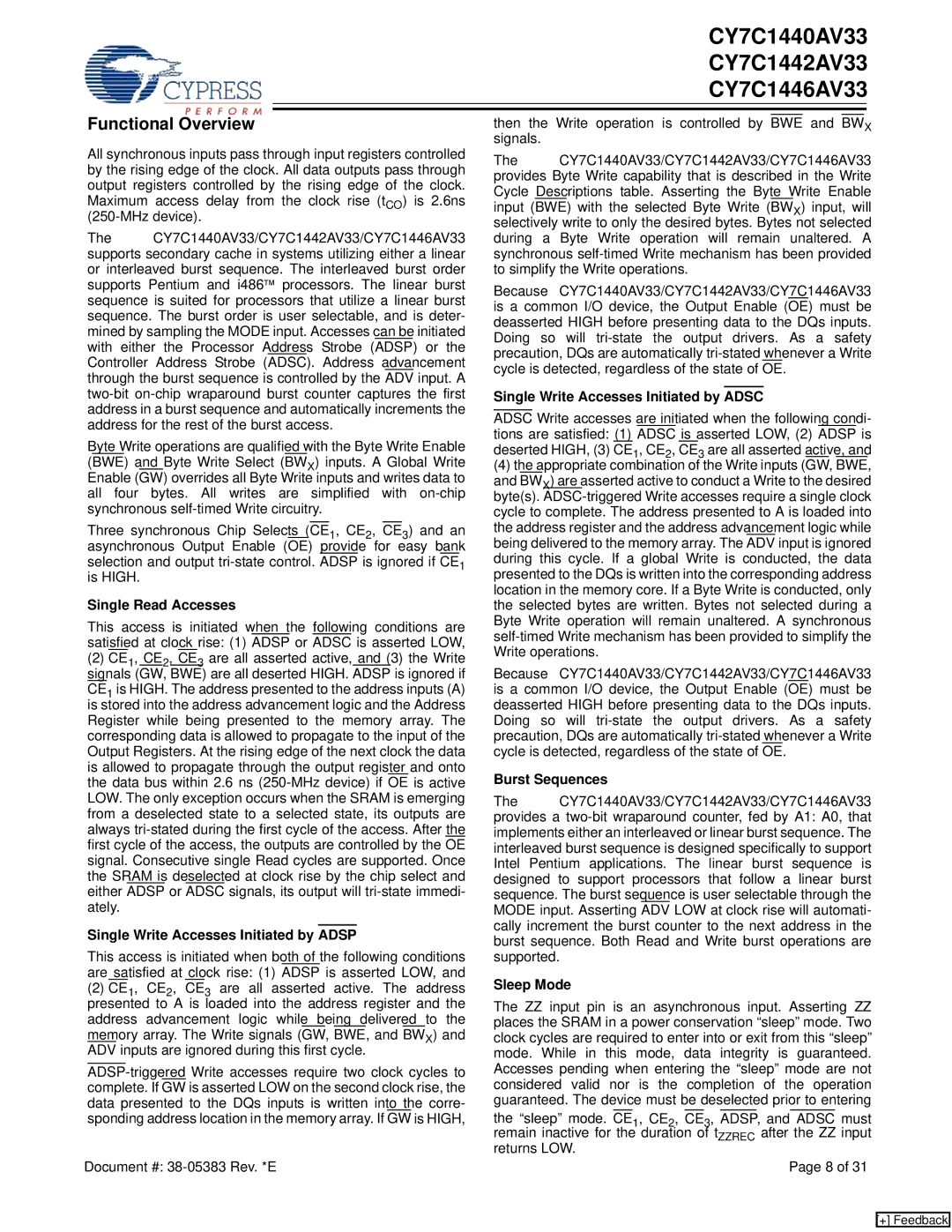
CY7C1440AV33
CY7C1442AV33
CY7C1446AV33
Functional Overview
All synchronous inputs pass through input registers controlled by the rising edge of the clock. All data outputs pass through output registers controlled by the rising edge of the clock. Maximum access delay from the clock rise (tCO) is 2.6ns
The CY7C1440AV33/CY7C1442AV33/CY7C1446AV33 supports secondary cache in systems utilizing either a linear or interleaved burst sequence. The interleaved burst order supports Pentium and i486™ processors. The linear burst sequence is suited for processors that utilize a linear burst sequence. The burst order is user selectable, and is deter- mined by sampling the MODE input. Accesses can be initiated with either the Processor Address Strobe (ADSP) or the Controller Address Strobe (ADSC). Address advancement through the burst sequence is controlled by the ADV input. A
Byte Write operations are qualified with the Byte Write Enable (BWE) and Byte Write Select (BWX) inputs. A Global Write Enable (GW) overrides all Byte Write inputs and writes data to all four bytes. All writes are simplified with
Three synchronous Chip Selects (CE1, CE2, CE3) and an asynchronous Output Enable (OE) provide for easy bank selection and output
Single Read Accesses
This access is initiated when the following conditions are satisfied at clock rise: (1) ADSP or ADSC is asserted LOW,
(2)CE1, CE2, CE3 are all asserted active, and (3) the Write signals (GW, BWE) are all deserted HIGH. ADSP is ignored if CE1 is HIGH. The address presented to the address inputs (A) is stored into the address advancement logic and the Address Register while being presented to the memory array. The corresponding data is allowed to propagate to the input of the Output Registers. At the rising edge of the next clock the data is allowed to propagate through the output register and onto the data bus within 2.6 ns
Single Write Accesses Initiated by ADSP
This access is initiated when both of the following conditions are satisfied at clock rise: (1) ADSP is asserted LOW, and
(2)CE1, CE2, CE3 are all asserted active. The address presented to A is loaded into the address register and the address advancement logic while being delivered to the memory array. The Write signals (GW, BWE, and BWX) and ADV inputs are ignored during this first cycle.
then the Write operation is controlled by BWE and BWX signals.
The CY7C1440AV33/CY7C1442AV33/CY7C1446AV33 provides Byte Write capability that is described in the Write Cycle Descriptions table. Asserting the Byte Write Enable input (BWE) with the selected Byte Write (BWX) input, will selectively write to only the desired bytes. Bytes not selected during a Byte Write operation will remain unaltered. A synchronous
Because CY7C1440AV33/CY7C1442AV33/CY7C1446AV33 is a common I/O device, the Output Enable (OE) must be deasserted HIGH before presenting data to the DQs inputs. Doing so will
Single Write Accesses Initiated by ADSC
ADSC Write accesses are initiated when the following condi- tions are satisfied: (1) ADSC is asserted LOW, (2) ADSP is deserted HIGH, (3) CE1, CE2, CE3 are all asserted active, and
(4) the appropriate combination of the Write inputs (GW, BWE, and BWX) are asserted active to conduct a Write to the desired byte(s).
Because CY7C1440AV33/CY7C1442AV33/CY7C1446AV33 is a common I/O device, the Output Enable (OE) must be deasserted HIGH before presenting data to the DQs inputs. Doing so will
Burst Sequences
The CY7C1440AV33/CY7C1442AV33/CY7C1446AV33 provides a
Sleep Mode
The ZZ input pin is an asynchronous input. Asserting ZZ places the SRAM in a power conservation “sleep” mode. Two clock cycles are required to enter into or exit from this “sleep” mode. While in this mode, data integrity is guaranteed. Accesses pending when entering the “sleep” mode are not considered valid nor is the completion of the operation guaranteed. The device must be deselected prior to entering
the “sleep” mode. CE1, CE2, CE3, ADSP, and ADSC must remain inactive for the duration of tZZREC after the ZZ input returns LOW.
Document #: | Page 8 of 31 |
[+] Feedback
